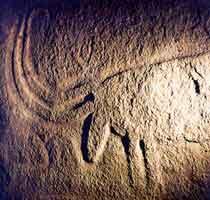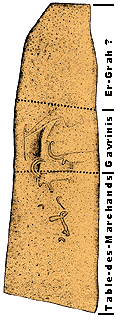- Home
- Discover the megaliths of Morbihan
- Art reflects the sacred
- Main works
- The large stele at the Table-des-Marchands and at Gavrinis
Next slide
Previous slide
The handled axe on the ceiling of the Table-des-Marchands.
The front section of the main bovine figure at Gavrinis, showing its huge horns with outward pointing tips.
Proposed reconstruction of the large ornamented stele. Its lower part is the ceiling of the Table-des-Marchands.
The most complete illustration of the handled axe motif can be seen on the ceiling of the Table-des-Marchands The axe is characterized by a triangular blade with a pointed butt and a thick shaft ending with a curve, which is reminiscent of the shape seen on axes found in marshes but also resembles the crosier sign.
This loop might also be a tie designed to make the wielding of the axe easier.
A large crosier can be seen above the handled axe. At the entrance of the passage, an elaborate carving is partly hidden by the top of a pillar stone and partly damaged by old splinters, originating from a fracture at the end of the slab. This pattern was therefore carved prior to the dressing and erection of the stone.
When excavated, the upper part of the slab concealing the Gavrinis chamber, revealed another motif:
- Two long arched horns and a spine line were engraved on the edge of a fracture. This decoration and that of the Table-des-Marchands both seem to represent a large animal with enormous horns.
- Above this fracture lies another animal with long arched horns, diverging at the top. In spite of the rather simplistic treatment of the body, the animal can easily be identified as bovine.
- The decoration is completed with a large 'axe-plough', the upper part of which has been destroyed by another fracture.
The two additional slabs make up the major part of a large orthogneiss stele. The stone is characterized by impressive decorative patterns: most of the signs are almost 2 m long.
Complete with the missing section (which may be the stone concealing the Er-Grah burial chamber, at Locmariaquer), the monolith, which may originally have been part of the alignment associated with the Grand-Menhir, would have been about 14 m long.
The stone now in Gavrinis must have been transported over more than 4 km, and would therefore have been floated across the Auray River.


